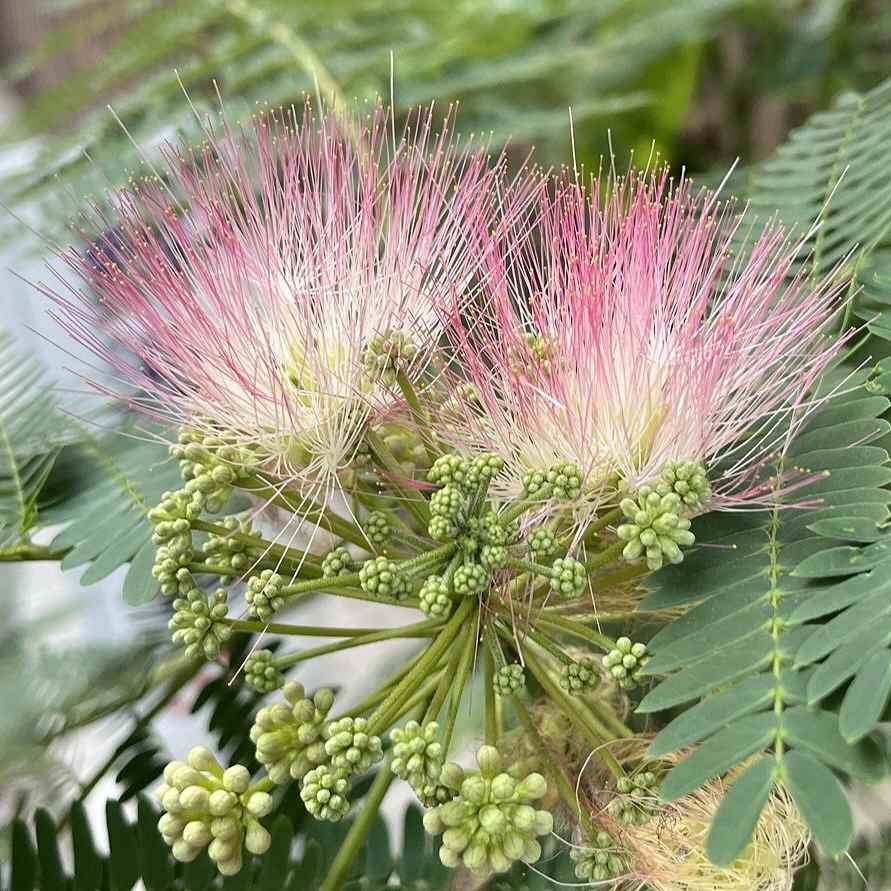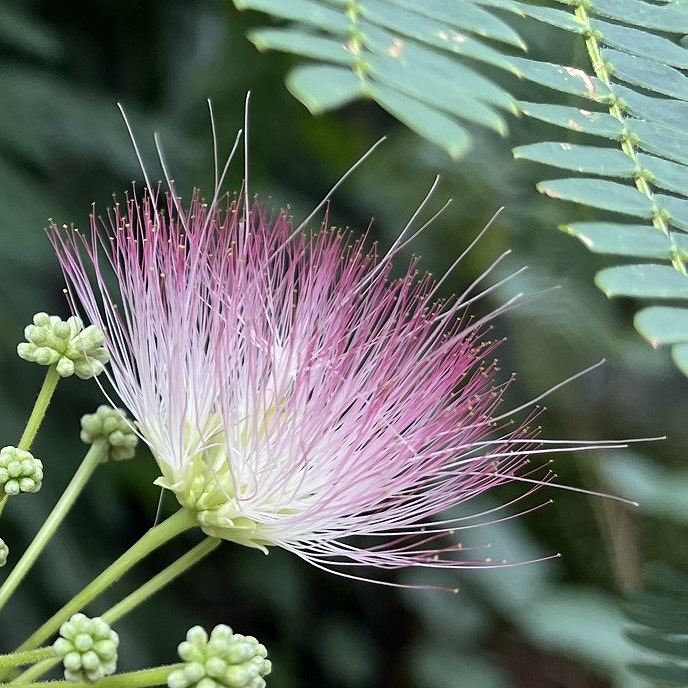ネムノキの花は天女の扇。仄かに桃のような甘い香りが漂います。名前の由来は日が暮れると小葉が閉じるから。眠っているように見えます。
Silk Tree flowers are celestial fans. It has a faintly sweet scent of peach. The name of Sleeping Tree in Japanese comes from the fact that the leaves close when the sun goes down. It looks like sleeping.
【仮名】ネムノキ
【和名】合歓木
【英名】Silk Tree, Pink Siris
【学名】Albizia julibrissin
【誕生】07/ 15, 08/ 17
【開花】06, 07, 08月
【花色】White, Pink, Red



ネムノキ
ネムノキの分布
ネムノキはマメ科の落葉高木。原産地はイランからアフガニスタンにかけての西南アジアです。熱帯由来であるにもかかわらず寒さに強く、インドや中国、台湾、朝鮮半島、日本にも分布。国内では本州から四国、九州、南西諸島まで、山野に自生したり、公園や庭園に植栽されます。
ネムノキの適地
ネムノキは塩害に強く、根粒菌の着生で空気中の窒素も固定するので、海岸沿いの痩せ地でも問題なく育ちます。一方、日当たりの悪いところや、乾燥したところは苦手。高い木の高いところに花が咲くので、それらを観賞しやすいよう、高みの近くに植栽するなどの工夫も必要です。
ネムノキの名前
ネムノキの名前の由来は「眠りの木」。日が暮れると葉柄が垂れ下がり、小葉が閉じて眠っているように見えるからです。葉は互生で、葉柄の両側に小葉が羽のように広がる羽状複葉。「合歓」は、男女がともに喜び楽しむという意味の中国語で、小葉が閉じる様子に由来しています。
ネムノキの開花
ネムノキの花は天女の扇。扇の要が白色、天が桃色です。花のように見えるのは雄しべ。先端に黄色の葯が着いています。その中で少し飛び出ている白色のツンツンが雌しべ。花は夕方から咲き、仄かに桃のような甘い香りが漂います。花後は扁平で細長い莢果を結び、熟すと褐色に。
ネムノキの利用
ネムノキは生薬の「合歓」に用いられます。灰褐色の樹皮は葉とともに利尿、強壮、鎮痛に、花は精神安定や不眠解消に。また、七夕の「眠り流し」にも関わりがあります。これは「悪霊が眠気をもたらす」という伝承に由来。地方によっては合歓木の葉を川に流して睡魔を払います。
Silk Tree
Distribution of Silk Tree
Silk Tree is a deciduous tall tree of the Fabaceae family. It is native to Southwest Asia, from Iran to Afghanistan. Despite its origin in the tropics, it is resistant to cold and is distributed in India, China, Taiwan, the Korean Peninsula, and Japan. In Japan, from Honshu to Shikoku, Kyushu, and the Nansei Islands, it grows naturally in the mountains and fields, and is planted in parks and gardens.
Suitable land for Silk Tree
Silk Trees are resistant to salt damage, and root nodule bacteria fixate nitrogen in the air, so they can grow without problems even in poor land along the coast. On the other hand, it does not like a place with poor sunlight or dry. Flowers bloom in high places on tall trees, so it is necessary to plant them near the heights so that they can be easily seen.
Silk Tree name
The Japanese origin of the name of Silk Tree is “Sleeping Tree”. When the sun goes down, the petioles droop and the leaflets close to give the appearance of sleep. The leaves are alternate and pinnately compound with leaflets spreading like wings on both sides of the petiole. The kanji character is a Chinese word meaning that men and women enjoy together, and is derived from the way the leaflets close together.
Silk Tree flowering
Silk Tree flowers are celestial fans. The base of the fan is white and the top is pink. Stamens look like flowers. It has yellow anthers at the tip. Among them, the white ones that stick out a little are the pistil. The flowers bloom in the evening and have a sweet peach-like scent. After flowering, flattened and elongated pods are formed, turning brown when ripe.
Use of Silk Tree
Silk Tree is used for herbal medicine. The gray-brown bark along with the leaves is used as a diuretic, tonic, and analgesic, and the flowers are used to stabilize the mind and relieve insomnia. It is also related to “Exorcising drowsiness” of Tanabata. This is derived from the legend that “evil spirits bring drowsiness”. In some regions, the leaves of the Silk Tree are thrown into the river to ward off sleepiness.


